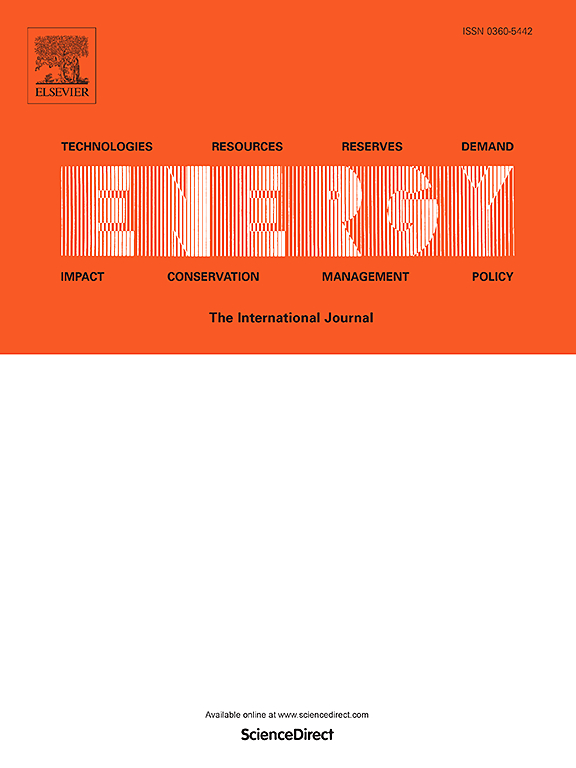先进核能系统中固态约束构件的热-力耦合行为分析
IF 9
1区 工程技术
Q1 ENERGY & FUELS
引用次数: 0
摘要
热管具有相变传热的优点,有可能取代流动冷却剂,从核反应堆中去除裂变热。然而,固态约束传热构型在力学性能和传热之间存在相互约束,其长期热-力耦合行为有待进一步研究。目前,对长期行为的研究仅限于单个/局部系统组件或单个物理领域。本文提出并验证了一种综合考虑热-力学性能、组分间相互作用和裂变气体释放的热-力学耦合行为分析方法。采用该方法对固态约束元件的工作特性进行了分析。结果表明,长时间的运行导致结构部件之间完全接触,产生高接触压力,增强了传热,但增加了蠕变。气态裂变产物的释放,随着运行时间的积累,导致间隙和外部接触压力同步增加,分别达到5.2 MPa和4.8 MPa。这一过程降低了气隙电导,导致系统峰值温度升高,温度安全裕度降低了43 K。热管失效后,继续运行会显著增加局部蠕变应变,达到正常情况下的3.9倍。优化间隙尺寸和燃料间隙压力,增强间隙传热,减小部件蠕变。在燃料配置中应避免过多的裂变气体释放。在单个热管故障后降低系统功率可以减轻部件蠕变并延长使用寿命。本文章由计算机程序翻译,如有差异,请以英文原文为准。
Thermal-mechanical coupling behavior analysis of solid-state constrained component in advanced nuclear energy system
With the advantage of phase change heat transfer, heat pipes have the potential to replace flowing coolants for removing fission heat from nuclear reactors. However, the solid-state constrained heat transfer configuration poses mutual constraints between mechanical properties and heat transfer, and their long-term thermal-mechanical coupling behavior requires further investigation. Currently, research on long-term behavior is limited to either individual/local system components or a single physical field. In this paper, an analysis method for coupled thermal-mechanical behavior is proposed and verified, comprehensively considering thermal-mechanical properties, interactions between components, and the fission gas release. This method is employed to analyze the operating characteristics of a solid-state constrained component. The results indicate that prolonged operation leads to complete contact between structural components, generating high contact pressure that enhances heat transfer but increases creep. The release of gaseous fission products, accumulated over operating time, results in a synchronous increase in both gap and external contact pressures, reaching 5.2 MPa and 4.8 MPa, respectively. This process reduces the gas gap conductance, leading to elevated system peak temperatures and a reduction in temperature safety margins by 43 K. After heat pipe failure, continued operation significantly increases the local creep strain, up to 3.9 times that under normal conditions. The gap size and fuel gap pressure should be optimized to enhance gap heat transfer and reduce component creep. Excessive fission gas release should be avoided in fuel configuration. Reducing the system power following a single heat pipe failure can mitigate component creep and extend the operational lifespan.
求助全文
通过发布文献求助,成功后即可免费获取论文全文。
去求助
来源期刊

Energy
工程技术-能源与燃料
CiteScore
15.30
自引率
14.40%
发文量
0
审稿时长
14.2 weeks
期刊介绍:
Energy is a multidisciplinary, international journal that publishes research and analysis in the field of energy engineering. Our aim is to become a leading peer-reviewed platform and a trusted source of information for energy-related topics.
The journal covers a range of areas including mechanical engineering, thermal sciences, and energy analysis. We are particularly interested in research on energy modelling, prediction, integrated energy systems, planning, and management.
Additionally, we welcome papers on energy conservation, efficiency, biomass and bioenergy, renewable energy, electricity supply and demand, energy storage, buildings, and economic and policy issues. These topics should align with our broader multidisciplinary focus.
 求助内容:
求助内容: 应助结果提醒方式:
应助结果提醒方式:


